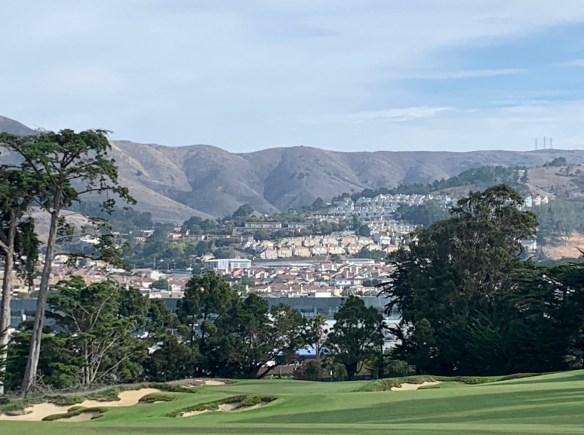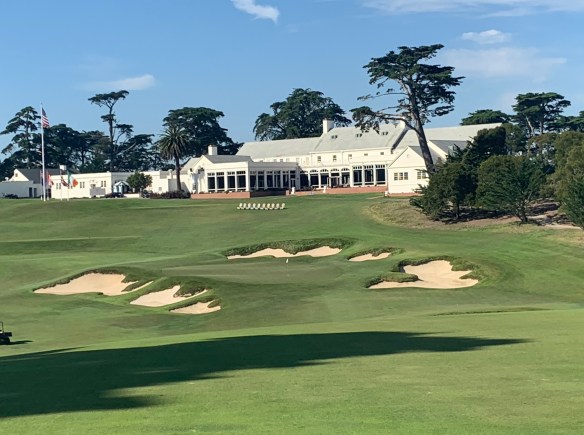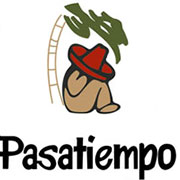 It is impossible to separate the character of this course from the reputations of entrepreneur Marion Hollins and renowned architect Alister MacKenzie, two seminal characters in the introduction and development of west coast Golden Age golf courses of the 1920’s. The two joined hands at Cypress Point setting a standard for what this area of the country could produce and their relationship was solidified with the development of what would become MacKenzie’s home course-Pasatiempo.
It is impossible to separate the character of this course from the reputations of entrepreneur Marion Hollins and renowned architect Alister MacKenzie, two seminal characters in the introduction and development of west coast Golden Age golf courses of the 1920’s. The two joined hands at Cypress Point setting a standard for what this area of the country could produce and their relationship was solidified with the development of what would become MacKenzie’s home course-Pasatiempo.
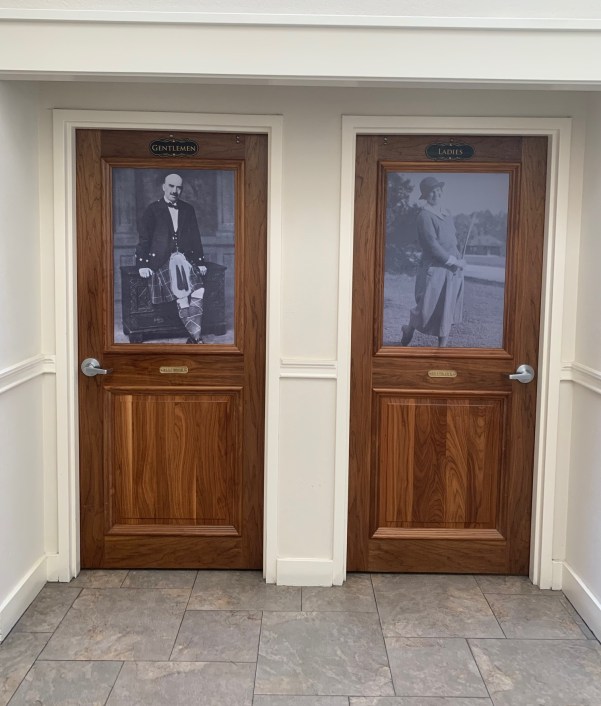
Dedicating the loos is an odd way of honoring the memory of these two larger then life characters who made this place possible
Marion was also responsible for introducing him to Bobby Jones, who would eventually tap Mackenzie to build his most famous creation of all in Augusta, Georgia. But seeing that MacKenzie lived here and tweaked the course right up until his passing one has to look at Pasatiempo as his swan song to the use of perception and deception in making so many great courses over his career.
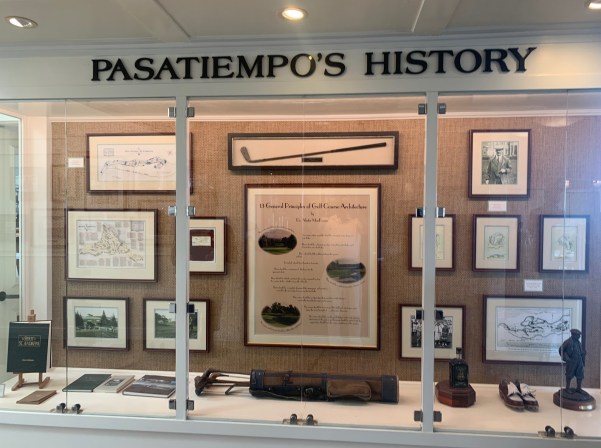
Plenty of history grace the walls and showcases through the clubhouse
Many of the great California courses like Riviera, Bel Aire, LACC, Pebble Beach, Cypress Point, and the Cal Club used the unique rolling terrain, prevalent arid conditions, and sandy soil to present a strategic version of golf where the movement of the ball initiated by the ground would determine success or failure in their play. We rarely hear the use of the term barranca in relation to golf architecture outside of this region, but in many ways these deep recessions created by nature of scrub, rock, and sand-often just dry bed streams, are the unique challenge that make California golf what it is.

For over 75 years they have held the Western Intercollegiate and you can see individual champions include Ken Venturi, Johnny Miller, Mark O’Meara, and Scotty Scheffler among others.
MacKenzie combined the use of barrancas with bold fairway undulations, slopy segmentation on the putting surfaces, and wildly diverse flash bunkering to make Pasatiempo the ultimate strategic test of golf. Power and length alone are no match for careful strategic planning and shot articulation when going around this place. Set against the stunning backdrops of the California coastal topography, the back nine presents the most varied array of holes that wed these parameters to challenge players of all caliber to be on their best game.

You can see the segmentation in this 2nd green makes you work the approach on the ground to get into the right section for the day’s pin position
Looking down the first two holes you get the sense that position off the tee relative to the segmentation of the green propagating varied pin positions is going to matter all day. When you see how MacKenzie works the slopes within the segmentation of the putting surface it becomes clear that it is not only approach angle that matters but use of the putting surface itself to move the ball into the most advantageous place to putt from. Three putts are in your day, delimiting them is important to keeping the bogie monster at bay.
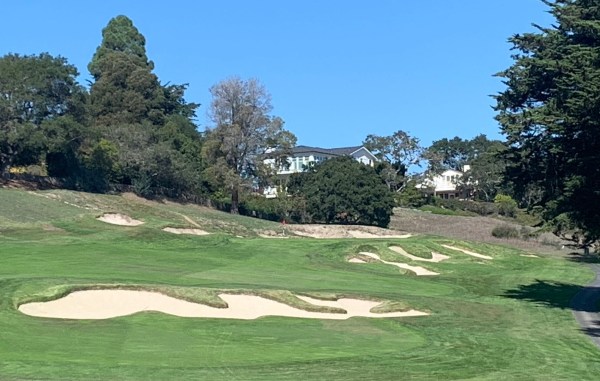
#3 is a Par 3 where your hybrid or long iron must carry the narrow entrance and a false front into a sloped green benched into the side hill
Two par threes in the next three holes that are the 2nd and 6th handicap holes tells you something about how challenging this day is going to be. The 3rd is a long uphill shot into a precipice green complex saddled by deep bunkers on both sides. Standing on the tee there is a enigmatic cross bunker that is 75 yards short of the green that will have you scratching your head as to why it is there. One needs to remember this hole was created in 1929 when hickory clubs were still around and elevating a Cleek on a long par three was not given.
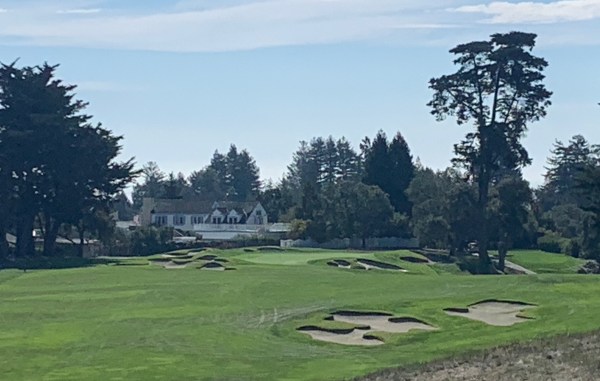
The array of bunkers off the tee and surrounding the green on #4 are emblematic of the MacKenzie style
The 5th is an even longer one-shotter then the 3rd and once again the uphill shot to the green will demand a solid club and a half more to cover the false front and bypass the massive bunker that dominates the left side approach to the green. The green is a four leaf clover so there are many corners when they can hide the pin.
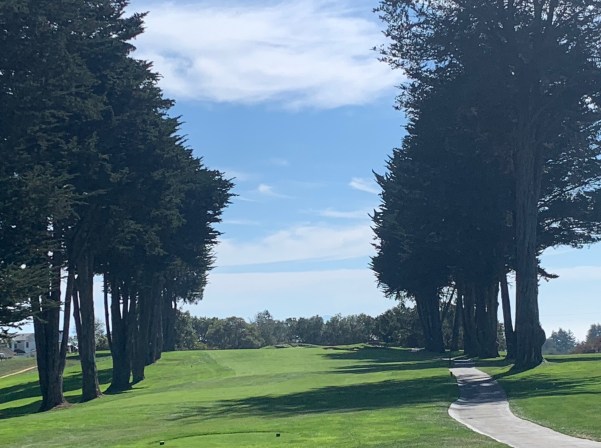
Drive off the 7th has to split the uprights to negotiate this narrow landing corridor.
The 7th and 8th are two really old school holes you just would not see built today which makes them a treat. The 7th is an appetizing uphill corridor short four which calls for a well positioned tee shot on the left side of the fairway to have a look up a narrow putting surface set on a 7 to 1 angle to the approach area. The green is segmented with countering slopes so it takes a really articulate short club to leave a birdie putt.

What a look down the hill at the 8th green wedged between steep slide slopes and bunkers to boot. The Par 5 9th is climbing the hill in the distance to the back of the clubhouse deck
As you step on the tee of the Par 3 8th your jaw will drop as you try to take in the parameters of the 45-yard long wildly contoured putting surface that sits at the bottom of the hill in front of you. If the wind is blowing all bets are off picking the right wrench. There is a line drawing of this green above the urinal in the MacKenzie men’s room in the clubhouse that depicts all the slopes and counter slopes he designed into this one. You might wish they handed them out on the tee for reference. Once your shot alights on the green it will work up the slope and feed toward the back left. This makes any front pin or back right pin extremely difficult to negotiate.
As you approach the ninth tee make sure to order a sandwich from the call box for the back nine……the barrancas are coming and you will need the protein shot in short order to cope.
Undoubtedly you have played courses where the front nine and the back nine look like brothers from a different mother, like Tralee where you go from banal flat seaside links to the vertical turbulent land of trolls once you step on the 11th tee. The stark transition here is similar but the distinguishing characteristic is not the topography itself but instead the use of nature’s singular feature, the barrancas which were intended to capture and move surface water during heavy rains but in their dryer form provide inherent surface movement and magnetic attraction to a ball struck with insufficient intent. What makes MacKenzie’s work so unique is that he fashioned countless iterations of this design element to influence your perception of strategic choices in subtle and not so subtle ways.

Looking at the required carry off the 10th tee you realize this barranca thing is about to become real and it is going to be unrelenting
Stepping on to the 10th tee the gaping rocky gorge at your feet is actually the simplest of the three interactions you will have with the barrancas on this hole alone. Once you drive it to the top the hill you feel the pull of the barranca well off the fairway to the left but then MacKenzie ingeniously integrates it into a cleaved array of bunkers and grass you must deal with the last sixty yards to the green.

The back end of the 10th the barranca takes on a tamer appearance but the magnetic attraction to roll out is undeniable
The most in your face barranca experience of the day is on the bifurcated fairway arrangement on the shortish par 4 11th. The rocky gorge haunts the left of the driving area forcing you to lay up at the end of the driving area just off the entrance to the steel bridge that traverses the chasm. The hole is now truncated to the left leaving the barranca on the right as you try to carry your approach up a significant incline to a green complex set into the back part of the abyss. Another narrow, stepped green awaits a long iron or hybrid approach earning this the 3rd handicap designation of the day.
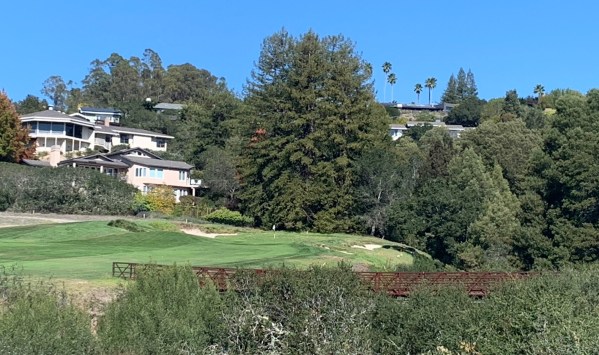
This is the harrowing look of the second shot approach to #11 that has to traverse the gaping gorge and find a safe landing spot of a steeply banked green precariously perched above the abyss
The switchback downhill par 4 that follows has the wooded barranca haunting a bad hook off the tee. From the center of the fairway the approach is into a triangular green wedged between bunkers and a fronting dry grassed shallow version of the barranca that will gather a ball with insufficient carry. You have already experienced six different iterations of the barranca effect in just three holes.
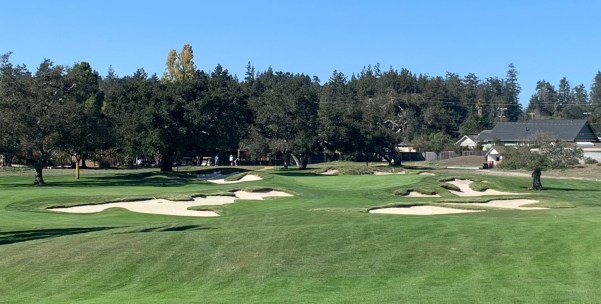
The Par 5 13th is probably the tamest hole on the inward half but once again MacKenzie emphasizes the contour of the barranca by lining it with sand as the pathway to a counter sloping green surface
White knuckle time over the next three holes begins on the par 4 14th as MacKenzie ups the barranca effect another notch by presenting it as fairway the left half of driving area. It is playable from down there but there is a good chance the depression is so deep you will not be able to see the flagstick from your approach position. A drive in the right half of the fairway at about 140 yards out puts you on a flat stance but the diagonal setting of this long and narrow green means you have to carry the fronting bunkers to get to the flag.

A close look at the Par 3 15th shows a footprint very similar to the 12th at Augusta…just a barranca to traverse rather then a piece of Ray’s Creek
The short pitch 15th is a dry bed version of the 12th at Augusta. The shallow green sits on the diagonal requiring a delicate forced carry with a series of deep bunkers and grass emanating out of the barranca. The entire back side of the green is cordoned by a bunker that will contain a long shot but the recovery shot from there is tricky as the green slopes away. Three here gains a shot on the field.
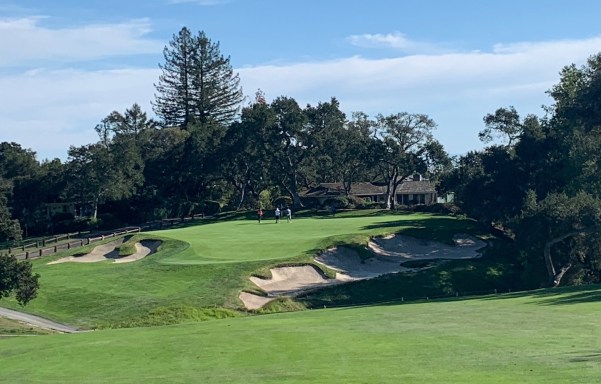
From over 150 yards out this approach into 16 is the most harrowing task of the day. Three steep tiers in this anvil shaped green with bunkers you will need a tow line to get in and out of
MacKenzie was particularly pleased with the challenge he presents on the #1 handicap hole in the next one. You drive from a low tee up a steep hill with a large mound dominating the right side of the landing area. The barranca flanks the driving area on the left so anything with too much draw can end up in the hazard. The conundrum is that the best drive is at the left edge of the large mound which feeds the ball left to a flat area with a good look up the green. This is the craziest green out of a collection of truly crazy greens in that it is a full 50 yards long with three distinct tiers, the first of which is impossible to keep your ball on. A humongous bunker will that covers the entire right side of the green will collect any approach with a hint of wandering fade and an up and down from there is highly unlikely. Good news is the green fans out in the second and third tier which gives a bit of wiggle room for an approach on the long side.

A look back up from the green on the final hole emphasizes the extreme elevation drop your ball will have to negotiate
One of the most memorable things about Pasatiempo is that it ends on a par 3 that is fully engaged with the deep gorge you had to traverse off the tee on #10. It is no more than a short to middle iron across but the green is a three clove shape that straddles the abyss and each section has drastic ground movement that makes keeping the ball in the desired section a task. Getting it on the green is half the battle…putting out in 3 putts or less is equally challenging.

The segmentation of the green itself makes it like three greens. There is so much back-to-front lean to the front barranca that matching speed and break is a three-putt possibility waiting to happen
A bit of an author’s disclaimer, this course is every bit as wonderful as I have described but it is in dire need of a total facelift. Tom Doak and Jim Urbina did a restoration of the course in 2007 and brought back a number of the MacKenzie parameters that had been dulled over the years. Urbina will be back starting in the Spring of 2023 to redo all the greens, bunkers, and fairways in an effort to bring this course’s condition and related golf amenities in line with it’s historical expectation.

One last thought is that the Pasatiempo logo may be the coolest golf logo ever…..it looks fabulous on everything. Make sure to give the golf shop a visit and find something cool to take home to savor your Pasa memories.
Santa Cruz, California
Architect: Alister MacKenzie (1929) and Tom Doak/Jim Urbina (2007/2023)
Par Rating Slope Yardage
Gold 70 72.5 141 6495
White 70 70.8 134 6093
White/Green 72 69.5 133 5780
Green 72 68.5 132 5595
Hollins 72 67.0 118 4438
(Click here to review the printable Pasatiempo Golf Club hole-by-hole descriptions)
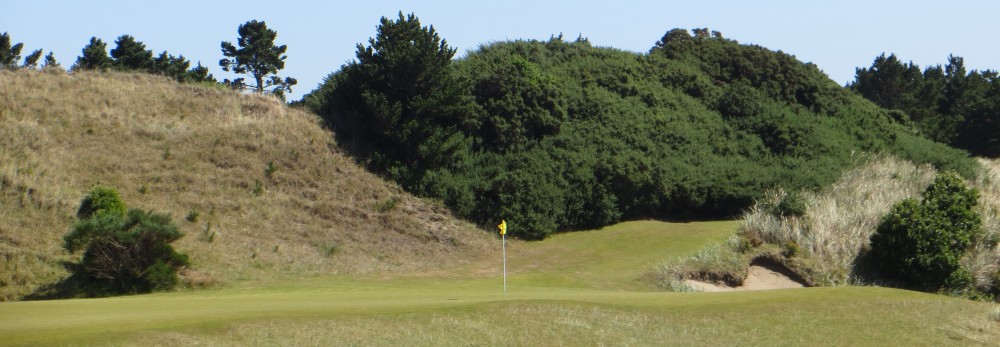
 The Golden Age of Golf Architecture left it’s imprint in San Francisco in the 1920’s and one of it’s finest contributions was the California Golf Club. The Cal Club is located at the southern end of the city in the hilly topography at the foot of San Bruno Mountain State Park. From the many high vistas throughout the property you can see the splendor of the city set against the mountain backdrop.
The Golden Age of Golf Architecture left it’s imprint in San Francisco in the 1920’s and one of it’s finest contributions was the California Golf Club. The Cal Club is located at the southern end of the city in the hilly topography at the foot of San Bruno Mountain State Park. From the many high vistas throughout the property you can see the splendor of the city set against the mountain backdrop.